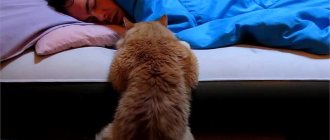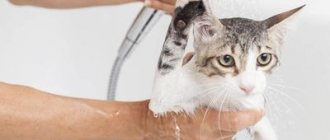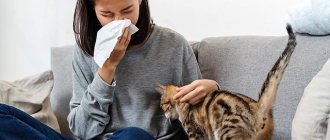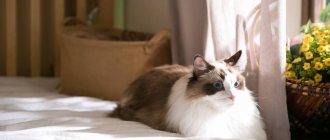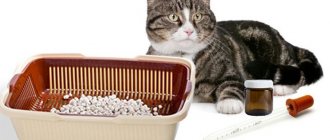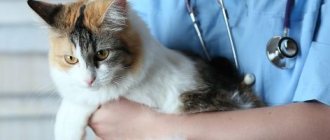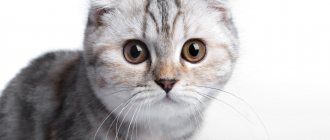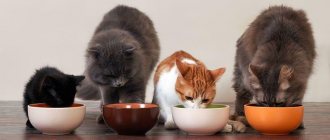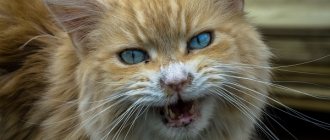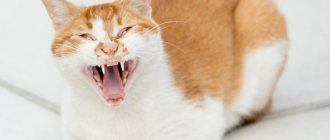Any rehabilitation of a cat after intestinal surgery includes correction of daily nutrition. It is also often difficult for owners to feed a cat that has recently suffered from stomach and other diseases. If your pet does not eat for several days, while its general condition worsens and other pathological symptoms are recorded, then you should immediately contact a veterinarian for help. To maintain the normal condition of a cat during illness, it is possible to feed it liquid food from a syringe and give it water in the same way.
Why does my pet refuse to eat?
When a kitten or adult is sick, the protective mechanisms of the immune system are reduced and the pet often refuses to feed. This reaction is normal for a weakened cat’s body, and owners should not worry too much or force-feed a sick cat. Usually the problem occurs in the first few days after an infection enters the animal’s body and another disease develops. After 2-3 days, the cat may ask for food on its own, or you should try to force-feed it with a small amount of food.
Veterinarians do not recommend allowing prolonged fasting during and after a cat’s illness, since the pet’s strength rapidly decreases and it is more difficult for the sick body to recover.
In most cases, the problem is associated with diseases of the gastrointestinal tract. The treatment process, during which the cat is given various drugs that reduce appetite, can affect impaired feeding. The reason may also be due to other factors:
A stressful state affects the animal's appetite.
- getting a foreign object into the throat or esophagus, which the pet cannot get rid of on its own;
- body bruise of varying severity;
- poisoning of the body;
- impact of stress.
How to syringe feed a kitten - what to feed and how often
If your kitten is motherless, its survival depends entirely on how well you take care of it. The ideal option is to find a surrogate cat mother who can feed your kitten (or kittens, if there are several of them). But this is not always possible. Therefore, if you need to handle the situation yourself, the most important task should be to provide the kittens with food and warmth. Nursing a kitten without a cat is a real possibility, but you must understand that new motherless kittens are very vulnerable and you will need patience to care for them.
Why force people to eat food?
During and after illness, you need to know how to feed your pet properly. Owners should not allow a complete and prolonged refusal to eat, since there is a high probability of complications developing in the kitten and adult. With prolonged fasting, recovery from illness is delayed in a pet. For a weakened body, at least the daily minimum amount of vitamins and essential microelements is extremely important. If the pet is not fed on time and force feeding is not introduced, then there is a high probability of developing exhaustion, which can be recognized in a cat by the following symptoms:
- weight loss;
- frequent vomiting;
- broken stool;
- pain in the abdominal area;
- deterioration of the condition of the cat’s fur and skin;
- weakness in the limbs;
- impaired sense of smell;
- apathetic state;
- reduction or complete absence of physical activity.
weight stages
An animal’s weight can tell you a lot: health status, rate of development, etc.
There are 5 stages of physical fitness in a cat:
If your pet is at the stage of exhaustion, overweight or obesity, urgent consultation with a veterinarian and nutritional correction is necessary!
Advice! To find out your pet's weight, weigh yourself on a bathroom scale. Then weigh yourself. Subtract your own from the total weight and find out how much your pet weighs.
This is interesting: What to do if the cat doesn’t eat?
Ways to force a kitten to eat
Sometimes it is more convenient to inject food into the animal with a syringe.
If your pet refuses to eat for several days after illness, then it is necessary to forcefully feed the sick cat. It is worth contacting a veterinary clinic, where they will conduct laboratory and instrumental examinations, assess the condition of the animal and select the necessary food or other food products. There are several ways to feed a cat after illness:
- On the gums. You should spread a tasty treat that may give the kitten an appetite.
- Through a pipette or syringe. In this way, it is possible to feed a weakened cat liquid food. The corner of the feeding aid is directed towards the molars. For the first time, 30 grams of milk or chicken broth is enough. If after taking liquid food there is no vomiting, then the procedure is repeated, increasing the dosage of food.
- At the root of the tongue. Calm the cat and place it on the left hand, as if holding a child. A small piece of meat, fish or liver is placed on the tongue and the cat’s mouth is closed, tightly fixing the jaw. It is recommended to pat your pet's throat to help him swallow food faster.
- Warming up food before eating. If, after an illness, a cat refuses to eat due to a runny nose, this may be due to a lack of sense of smell. To eliminate the problem, you need to reheat the food before serving so that it releases pleasant aromas. In this case, the pet is more likely to smell the food and eat it.
Recommendations for owners
A pipette can be useful if the animal does not want to drink on its own.
Owners should be patient, since during and after an illness it is often necessary to force-feed the cat for a long time until complete recovery and recovery. It is equally important to provide your pet with 24-hour access to water, and you can also give him liquid on an empty stomach to increase his appetite. If you refuse to drink, use a pipette and forcefully pour liquid into the cat’s body after illness.
Reasons for refusing water
To restore your cat's interest in water, change the bowl first.
If your cat won't drink water from his bowl, he may not like the dishes, or he may be drinking from a toilet, dripping faucet, bucket, or other kitchen container.
Psychological reasons for refusing water:
- uncomfortable bowl;
- there is stagnant water in the drinking bowl;
- food from a nearby bowl got into the liquid;
- after playing with water she became dirty.
Having identified the reason for refusing water, it is important to eliminate it.
Syringe feeding
If the pet is severely weakened due to a protracted illness, then it is possible to feed the cat in this way. You should first contact a veterinary clinic, where a specialist will tell the owner how to feed the animal correctly and which syringe to use. In most cases, a 2 mm medical device is suitable. The tip of the feeding agent is first cut off so as not to damage the cat’s mucous membranes or cause other damage. Rough edges are sanded until they become smooth. The food that needs to be fed to the cat after illness must be liquid so that it can be filled into a syringe. Using a piston, food is drawn into a tube and brought to the pet’s nose so that it can taste the food.
If the animal refuses to lick the food, it is introduced forcibly. It is recommended to wait until the cat opens his mouth slightly, after which he slowly squeezes the food onto his tongue. Do not suddenly introduce all the food at once, as the cat may vomit it soon. When a pet refuses to open its mouth on its own, the owner should slightly unclench the jaws with the help of his fingers. After the manipulation, the cat is consoled, petted and praised so that he does not have fear before the next feeding.
How to give medicine to a cat mixed with food
The easiest and safest (for humans) way to properly give medicine to a cat is to crush the tablet and mix it with the cat's food. This works great in some situations.
- carefully grind the tablet to a powder, leaving no large pieces (the cat will pick them out from the food and will not eat them);
- mix the medicine with food of liquid or semi-liquid consistency to obtain a homogeneous mass;
- choose fragrant and favorite food for the cat in order to mask the taste and smell of medications as much as possible.
The catch is that the cat may refuse its favorite food if it smells the chemical smell of the pills. But it's worth a try. It goes without saying that this option is absolutely not suitable, since the drug must be taken on an empty stomach.
Drug release form
It is worth noting that medications are available in various forms: tablets, powders, suspensions, etc. The easiest way to properly administer medicine to a cat is by giving it the suspension through a syringe. However, the strength of the suspension is often lower than that of dry tablets.
Before giving your cat medicine for worms, read the instructions and information on the topic, weigh the cat so as not to make a mistake with the dosage. Have a complete understanding of the process to avoid unpleasant surprises.
Source
How can a pill dispenser help?
To facilitate the process of deworming or treating animals with tablets, you can use a special device. It is called a piller, introducer or tablet dispenser. The design of this device resembles a syringe. The tablet dispenser has a piston and a flexible tip with several holes.
Before the procedure, the tablet is placed in a rubber tip. The cat, as in other cases, must be restrained. Having opened the pet's mouth, the owner places the piller in it and presses the piston. After this, you need to squeeze your jaws tightly and hold them closed.
Introducers vary in size and tip openings. There are devices for both large and small tablets. Everyone can choose a tool for adult cats and kittens. You can see what the device looks like in the photo.
Nutrition after castration/sterilization
Before giving your pet food, you need to know exactly its weight. Periodic weighing allows you to promptly identify any problems with your pet’s weight in the postoperative period. Obesity is very dangerous for sterilized individuals, since their metabolism is much slower.
If the animal is overweight, you need to reduce the amount of food consumed. Minimum feedings – 2 times a day. For overweight cats, a fractional diet is best. This will help stabilize the digestive tract. When feeding “natural”, preference should be given to high-quality meat.
If the owner feeds prepared diets, it is recommended to purchase a high-quality food intended for spayed/neutered individuals. Combining “drying” and “natural” in one serving is strictly prohibited.
You cannot feed your operated pet with economy food. A sudden change of brand is also not welcome. This means that you cannot switch your pet from high-quality food to, for example, Kitekat. To feed sterilized cats and neutered cats, you need to choose professional dietary food - Royal Canin or ProPlan. Moreover, Royal Canin takes into account the gender, age and preferences of the pet.
Correctly selected food provides:
- stabilization of appetite;
- shine and smoothness of the coat;
- normal digestion.
